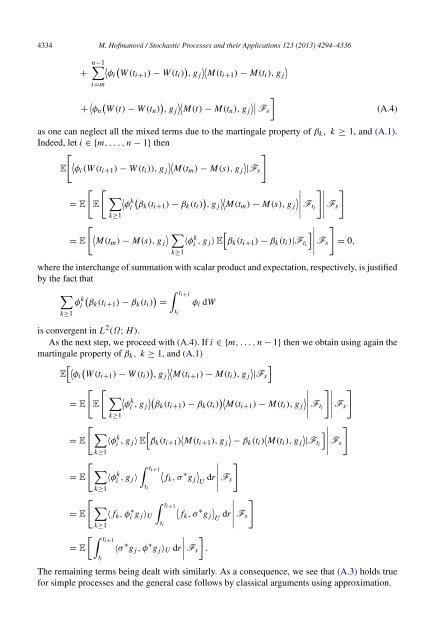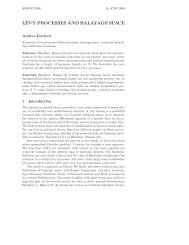Degenerate parabolic stochastic partial differential equations
Degenerate parabolic stochastic partial differential equations
Degenerate parabolic stochastic partial differential equations
Create successful ePaper yourself
Turn your PDF publications into a flip-book with our unique Google optimized e-Paper software.
4334 M. Hofmanová / Stochastic Processes and their Applications 123 (2013) 4294–4336<br />
n−1<br />
<br />
+ φi W (ti+1 ) − W (t i ) <br />
, g j M(ti+1 ) − M(t i ), g j<br />
i=m<br />
+ φ n<br />
<br />
W (t) − W (tn ) , g j<br />
<br />
M(t) − M(tn ), g j<br />
F s<br />
<br />
(A.4)<br />
as one can neglect all the mixed terms due to the martingale property of β k , k ≥ 1, and (A.1).<br />
Indeed, let i ∈ {m, . . . , n − 1} then<br />
<br />
φi <br />
(W (t i+1 ) − W (t i )), g j M(tm ) − M(s), g j |Fs<br />
E<br />
= E<br />
<br />
E<br />
<br />
k≥1<br />
φ<br />
k<br />
i<br />
<br />
βk (t i+1 ) − β k (t i ) , g j<br />
<br />
M(tm ) − M(s), g j<br />
<br />
F ti<br />
<br />
F s<br />
<br />
<br />
M(tm <br />
= E ) − M(s), g j ⟨φi k , g j⟩ E β k (t i+1 ) − β k (t i )|F ti F s = 0,<br />
k≥1<br />
where the interchange of summation with scalar product and expectation, respectively, is justified<br />
by the fact that<br />
<br />
φi<br />
k<br />
k≥1<br />
<br />
βk (t i+1 ) − β k (t i ) =<br />
ti+1<br />
t i<br />
φ i dW<br />
is convergent in L 2 (Ω; H).<br />
As the next step, we proceed with (A.4). If i ∈ {m, . . . , n − 1} then we obtain using again the<br />
martingale property of β k , k ≥ 1, and (A.1)<br />
φi <br />
E W (ti+1 ) − W (t i ) <br />
, g j M(ti+1 ) − M(t i ), g j |Fs<br />
= E<br />
= E<br />
= E<br />
<br />
E<br />
<br />
k≥1<br />
φ<br />
k<br />
i , g j<br />
<br />
βk (t i+1 ) − β k (t i ) M(t i+1 ) − M(t i ), g j<br />
<br />
F ti<br />
<br />
F s<br />
<br />
<br />
⟨φi k , g j⟩ E β k (t i+1 ) <br />
M(t i+1 ), g j − βk (t i ) <br />
<br />
M(t i ), g j |Fti F s<br />
k≥1<br />
<br />
⟨φi k , g j⟩<br />
k≥1<br />
ti+1<br />
<br />
ti+1<br />
= E ⟨ f k , φi ∗ g j⟩ U<br />
k≥1<br />
t i<br />
ti+1<br />
= E ⟨σ ∗ g j , φ ∗ g j ⟩ U dr<br />
t i<br />
t i<br />
<br />
fk , σ ∗ g j<br />
<br />
U dr <br />
F s<br />
<br />
<br />
fk , σ ∗ g j<br />
<br />
U dr <br />
F s<br />
<br />
F s<br />
<br />
.<br />
The remaining terms being dealt with similarly. As a consequence, we see that (A.3) holds true<br />
for simple processes and the general case follows by classical arguments using approximation.



